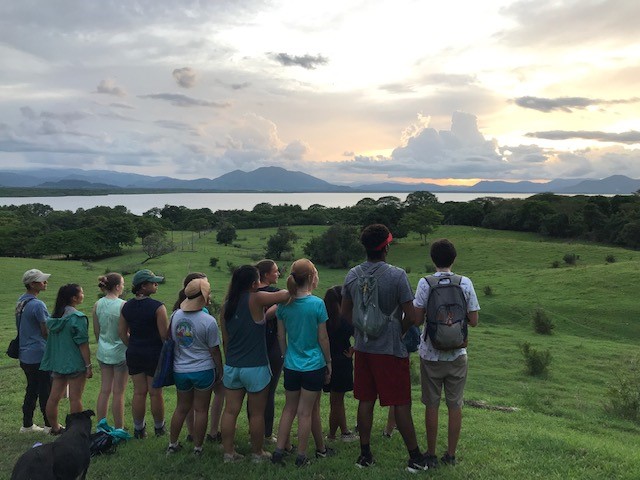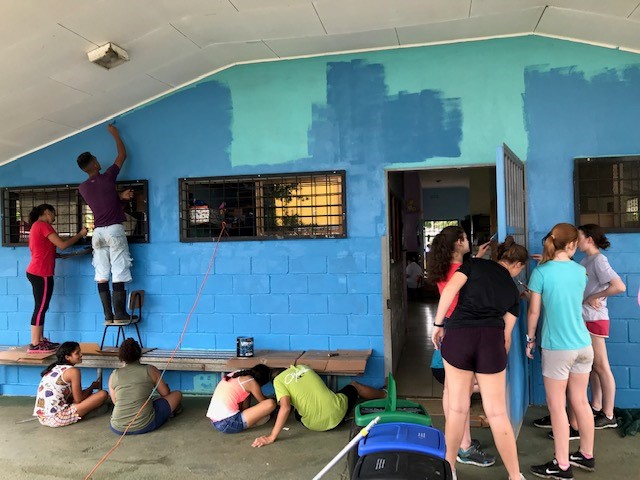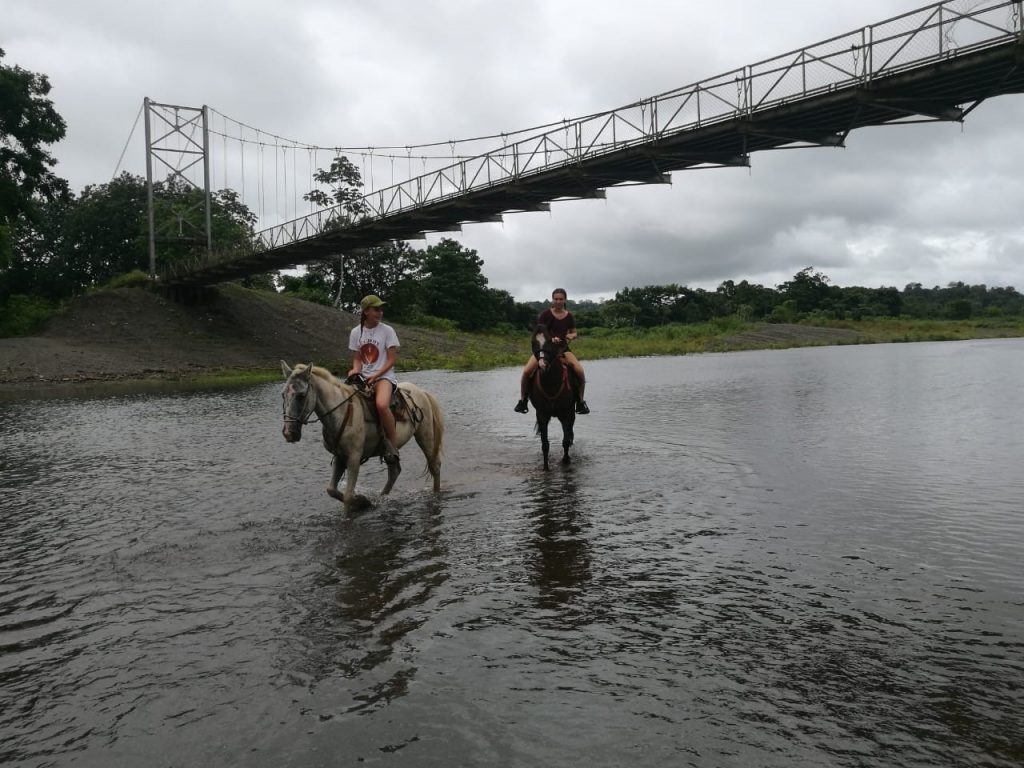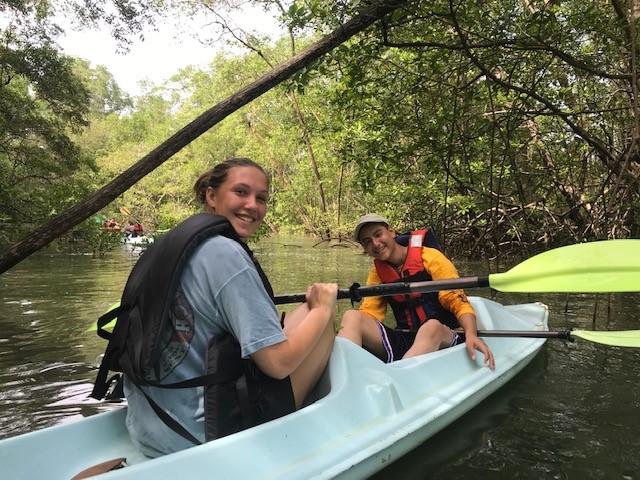




Blog 2
For twelve days we lived with a host family. This was such an incredible opportunity to become fully immersed in the daily life of a Costa Rican family and community. During our time in La
Palma we participated in cultural exchange by practicing our Spanish language skills, exploring the community and the surrounding area of Puerto Jimenez, learning new skills such as how to drink from a coconut and peal out the “meat” inside, how to make tortillas and empanadas, how to kill a chicken, ride rural horses, and play new games.
More fun was had during family bingo night, where fortunately, everyone was a winner and got to take home a prize, or two. Beach day was SO much fun, too. It seemed like everyone’s sibling, aunt, uncle, cousin, etc., came out to play. Where there was a group game, whether volleyball, soccer, or swimming in the water, everyone was involved.
Aside from the organized activities, our families kept us well cared for by washing our laundry (without giving us the chance to wash it ourselves!), giving us fresh water, coffee, snacks and serving delicious food at breakfast, lunch and dinner times. We felt the pressure to finish our heaping plates of food and resisted the temptation to moan when a second serving was offered. Gallo Pinto every day!
The pace of life was certainly a lot slower, sometimes boring, and felt at times a little stagnant. We arrived to begin our stay on a high, excited more than ever to meet our families and see the community. Yet, there in La Palma, life was slow. Even with so many new activities accompanied by new smells, sights, and sounds, we were finally confronted with the lows: culture shock and integration. These feelings became palpable when we started to adjust to the day to day. There were empty and quiet moments where conversations could grow silent as we struggled to understand each other and communicate. Sometimes non verbals were all we could use to get a message across. Sometimes google translate was heaven sent. There were awkward moments and times where tears fell out without warning because we were processing our thoughts and emotions at the same time as trying to explain and express them in a new language. However, eventually we grew accustomed and we recovered then adapted, even if we didn’t realize it at the time.
We had project work in the mornings at 7:30 am, went home for lunchtime with our families, had the evenings free before dinner time and typically went early to bed. Often at 8pm! Our community service project was based at a local school, where low income families can receive good school care and even meals for their children. Our job was to fix the place up! We had many projects within this project, beginning with putting a fresh face of paint on the front of the school and on the surrounding border. After this first step, we created images to create a mural on the front entrance. Our work looks like it was done by professionals. Ready for hire!
We also built a fenced in garden for the children to plant and grow things in, and really cleaned up the place by painting even the tires and rocks. We made a huge difference. The place has more life in it and on our last work day, we got a chance to play with the little ones, soaking up the vision of them enjoying what we all worked so hard on.
With some tears in our eyes, we said adios to our host families and took off for our 9 hour transfer towards the Central Pacific area of Costa Rica to Costa de Pajaros, Puntarenas to take a boat to Isla Chira. Upon arrival, we were met by our new bus driver and took our small packs with us to our next spot: La Posada de Amistad, a women-owned and operated sustainable rustic cabins for our sleeping quarters.
Blog 3
Isla Chira is a Pacific Costa Rican island at the upper end of the Gulf of the Nicoya that contains the most intact biodiversity of tropical dry forest flora in the entire country, if not all of Central America. It is also Costa Rica’s largest island. The majority of the island’s population is made up of three villages and the approximately 3,000 residents on the northern edge. Our mission for the next three days was to explore the island and it’s community’s sustainability, ecology and biodiversity.
During our days at La Amistad, we ate healthy portions of delicious food: gallo pinto, yucca, mussels, fresh island caught fish, eggs, and a variety of fruit juices, native to Costa Rica. We spent an afternoon and evening on Playa Muerto (death beach) after a morning of community service of sanding, painting, and helping in the construction of a tire wall for soil retention. The other evenings were spent enjoying one another’s company with card games and lots of laughter. There was hard work but a lot of time to play and enjoy one another.
The main economic activities of those living on the island are fishing, farming, and working on the salt pans. Our in-country guide, Maguil, works and lives here overseeing many of these family-run projects, encouraging the local people to keep striving for more and to look towards sustainable development projects that will help their families.
We were lucky to have Maguil take us on a nature hike to learn about local plants and animals as we hiked up to the water tower to enjoy the sunset. After seeing so many large crickets in our rooms, we learned that they are harmless- thank GOD.
One night we were treated to a beach dinner! We didn’t even have to do anything but hang out at the beach and wait for the food to come. It was delicious – fish, yucca, rice and beans and a perfect sunset.
Blog 4
We left Isla Chira and rode in a boat through the mangroves, seeing pink flamencos and other tropical birds all around us.
Now we are in the North Pacific side of Costa Rica where the Ostinal Turtle Project is located. We are here to learn about the work of The Local Guides Association of Ostional, a local organization that supports local sea turtle observation. This group has been working closely with the National Refuge of Wildlife of Ostional, part of the Ministry of Environment & Energy, and the cooperation of university of Costa Rica. They are focused on establishing conditions for a self-sustaining development, the community of Ostional has worked in areas of conservation, economic development, awareness and education.
An incredible experience our first night in Ostional! We watched a Lora Turtle dig a 2 feet deep hole, begin her process of getting into a trance, and then dropping her 80-120 eggs into the hole. Even more spectacular was how she then spent 15 minutes covering them up and patting down the sand over them to camouflage her work. When she finished that tiresome labor, she started to make a move for the ocean. Following close behind her, we got this sweet opportunity to bid her farewell into the dark night she disappeared into the waters. What we learned: they can conceive up to around the same age as humans- 50 years. They can hold sperm for two years before arriving on shore to drop their eggs. The whole process of coming to shore, digging a hole, laying the eggs, covering them up and camouflaging the process then carrying themselves back to the ocean takes about 45-60 minutes. The egg laying takes about 15 min. Speaking specifically about the turtles themselves, their sizes change as they grow older with the younger turtles carrying flatter shells and the older turtles forming more rounded out shells. Speaking about their shells, they have more defined squares as young turtles, like boxes, while the older turtles lose this defined pattern due to living in a tough environment, such as the ocean. In time, these squares turn into crisscross scratches. My favorite part of watching this process was seeing her up close, so close I witnessed her mouth open and tired breathing, closing and blinking of the eyes, and the breaks she took between kicks to cover up her eggs. We could not photograph nor could we take video because the white light would disturb her in her process so we watched patiently with open eyes in awe of this dinosaur giving birth.
Interestingly, the Ostional community depends on these turtles to come ashore and lay eggs for a source of economy. People eat the turtle eggs. This is Costa Rica’s only location where it’s legal to rely on the production of eggs for sale and consumption. The local community and the venders are responsibility for taking care of the turtles and their babies. There is a very seriously kept contract for selling turtle eggs as an economic endeavor; people must clean up the beach for the arrival of the turtles. This means no plastic, no trash from candies or lollipops, cans, bottles, netting, etc. To help with this effort, our Experiment group worked alongside a local organization to clean up the streets and surrounding community. With trash bags and gloves in our hands, we set off to pick up litter of all kinds to limit the dangers these turtles and other species.
As a reward, we were driven to a beach to relax in the water and sun. Many of us walked the beach, climbing the discovering marine life on rocks and in the water. Others played volleyball and swam. What a treat!
Blog 5
To wrap up our month of adventures, we landed in Punta de Leona for some REAL relaxation. We had very comfy beds, rooms with AC and NO bugs, loads of white-faced monkeys hopping about, private pools and the ocean at our back door. We got to play volleyball, ping pong, basketball, swim and relax. The meals were AMAZING, with a full buffet at every meal.
On our second day here we loaded up again for a half day trip to enjoy the sun on a catamaran. What a trip on the open waters! We saw two turtles in a tight embrace. Our boat guide explained to us that the turtles were mating. Then we saw a humpback whale and her baby! It was an incredible ride. Although we didn’t see any dolphins this trip, we did get to jump off the boat into the water and slide down two slides and eat like kings and queens.
To wrap up our time in Costa Rica we concluded with bowling. After we feasted on pizza and bowling food, received our Costa Rica t-shirts, we loaded up the bus to the Riviera Hotel where we started our journey one month ago.
This really has been a trip to remember. Pure Vida mae!


